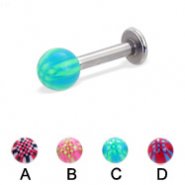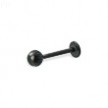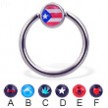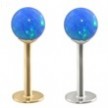Labret with acrylic checkered ball, 12 ga
- Gauge (Thickness): 12 (2.0mm)
- Material: 316L surgical grade stainless steel
- Material: acrylic
- Type: labret
Shown: 10mm labret with 6mm ball.
| Click on the picture to see a big picture and description of the body jewelry you are interested in. | |||||||||
|---|---|---|---|---|---|---|---|---|---|
|
Black notched ball labret, 16 ga
$9.99
Black notched ball labret, 16 ga
Shown: 10mm labret with 4mm ball. |
Captive bead ring with logo ball,...
$6.99
Captive bead ring with logo ball, 14 ga
|
14K Gold Labret with Blue Opal...
$49.99
14K Gold Labret with Blue Opal Balls
|
Square captive bead ring, 16 ga
$3.99
Square captive bead ring, 16 ga
Shown: 3/8" captive bead ring. |
||||||
ASSESSING ANATOMY AND JEWELRY SELECTION
The piercer should discuss the viability of the piercing with regard to the client's anatomy, daily activities, and to what purpose the piercing serves. Not everyone is anatomically suited for every piercing. A piercing should not be attempted if not enough tissue is available to support the piercing. Some people's daily activities or sports prohibit certain piercings or prolong healing.
Piercings made in flat areas have a greater tendency to migrate or reject (grow out). The optimum area to be pierced is one in which the piercing will be perpendicular to the tissue, like an earlobe piercing. The more a piercing deviates from perpendicular the greater the pressure between the jewelry and the tissue.
Wearing jewelry of the proper metal, design, and dimensions (gauge and diameter) is important for a successful piercing. The jewelry should be chosen after assessing the viability of the piercing and taking the required measurements. Everyone is built differently, and the jewelry must be selected accordingly. Jewelry that is too thin in gauge is more easily rejected by the body. Wearing jewelry that is too thin increases the risk of the piercing being torn or ripped completely through if the jewelry gets caught or pulled. Wearing jewelry that is too thick and heavy may cause the piercing to migrate or reject. The gauge must not be so thick that the strength of the tissue is compromised.
The diameter or length of the jewelry must be chosen carefully. Some piercings tend to swell during the healing period. Wearing jewelry that is too small in diameter or length creates pressure on the piercing and the piercing will migrate or reject to reduce the pressure.
The jewelry should be new and should be polished to a mirror-like shine, regardless of the type of metal. Previously-worn jewelry can have minute scratches which can irritate a new piercing and trap bacteria. Oral jewelry is often scratched even after only a short time of wear. Oral jewelry also collects plaque which is very difficult to remove, especially around threads.




